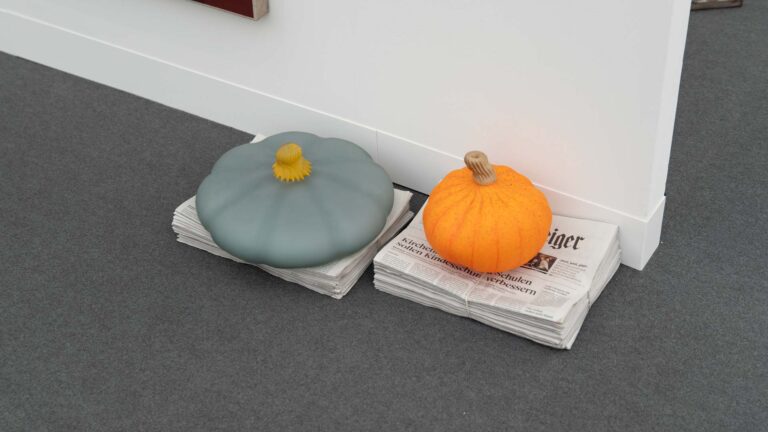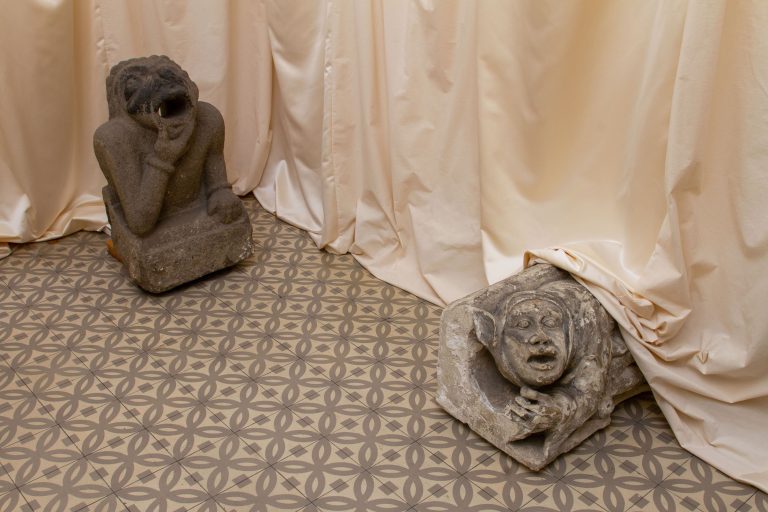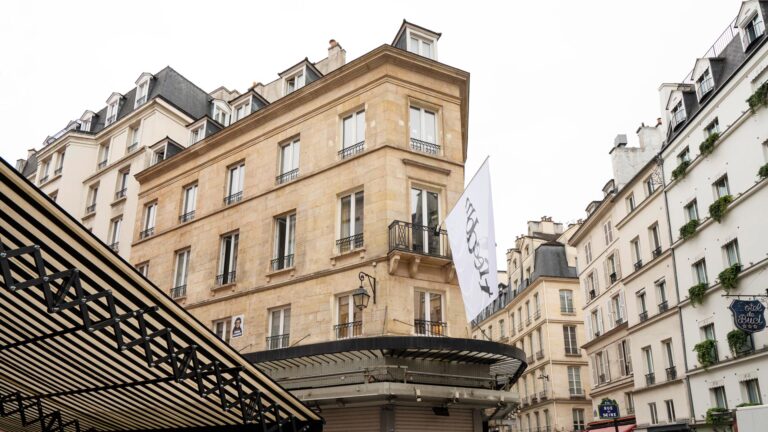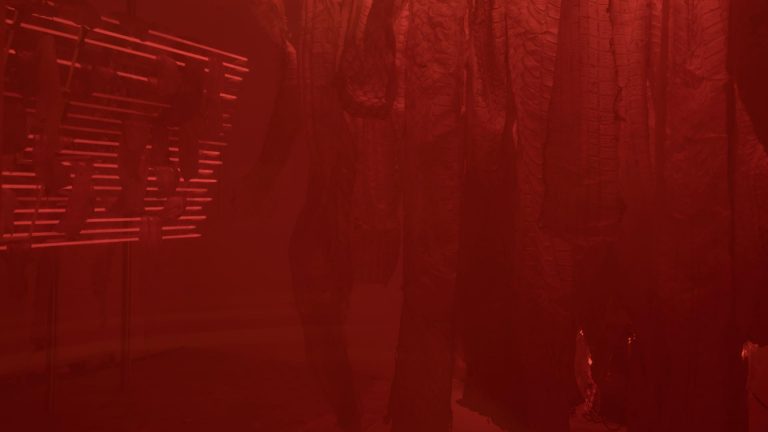Artists: Mathieu Kleyebe Abonnenc, Lawrence Abu Hamdan, Zbyněk Baladrán, Éric Baudelaire, Julien Bismuth, Maxime Bondu, Anetta Mona Chişa & Lucia Tkáčová, Nemanja Cvijanović, Loreto Martínez Troncoso, Roman Ondák, Christodoulos Panayiotou, Sébastien Rémy, Matthieu Saladin, Charlotte Seidel, Remco Torenbosch, Cyril Verde, Marie Voignier, Lois Weinberger, Carla Zaccagnini, As Well As H.A. Schwartz, Eichstaedt, Kern, Dziurzynski, Ramones, Agrawal, Shah, Kosinski, Stillwell, Seligman, Ungar
Exhibition title: Tension Economy
Curated by: Émile Ouroumov with Catherine Pavlovic
Venue: Parc Saint Léger, Pougues-les-Eaux, France
Date: May 29 – August 28, 2015
Photography: Emile Ouroumov, all images copyright and courtesy of the artists and Parc Saint Léger, Pougues-les-Eaux
Through the works of some twenty artists from various countries and generations, along with a group of scientists, the show titled “Économie de la tension” (Tension Economy) aims to explore in what ways these practices take a stance on current issues.
The title of the show reappropriates the notion of the “attention economy” recently analyzed by the researcher Yves Citton in Pour une écologie de l’attention and L’Économie de l’attention. Nouvel horizon du capitalisme? (2014) According to this theory, in a world in which there is an overabundance of information, our attention regimes are henceforth characterized by intellectual availability as a scarce resource – at the risk of transforming minds into commodified capital. Far from being something recent, the observed phenomenon has only expanded with the Industrial Age, gradually becoming hegemonic with technological advances at a time when digital networks are widespread. It concerns such diverse spheres as the economy, advertising, the media, education, research, and culture, by focusing in a biased way on a limited set of parameters and an obsession with the quantity rather than the quality of attention. “More broadly, each time an evaluation process is set up (of government services, hospitals, schools, etc.), that process contributes to actively producing the values it claims to be content to objectively observe, creating recursive loops that overwhelm our compasses.”[1]
What is art’s position with respect to this “attention race,” and what are artists’ role and degree of involvement in society?
In France, with the spring of 2016 we see a desire to reappropriate public affairs. Redefining the participatory character of a democracy, this new awareness goes beyond the formal framework of traditional social movements. It takes shape notably around the popular protest movement known as “Nuit debout” (Up at Night), which has opened a new type of space for debates and proposals. The mistrust there of the mass media gives voice to a desire to renegotiate the field of attention in the space of media, rethink the tools for analyzing society, and even create new ones that reflect a plurality of viewpoints.
It is interesting to compare this new societal desire with those in the field of art. Not inaccurately a recent article entitled “Il se passe quelque chose… (sauf dans la culture)” [2] critiques the superficial commitment of and comfortable distance that is maintained by the art world in general and its institutions in particular—commitment and distance being given voice in statements that remain empty rhetoric.
The debate touching on the social function and usefulness of art is certainly nothing new. In particular, the 20th century witnessed a divergence between modernism, which defended the specificity of the esthetic domain, and the avant-gardes, which aimed to abolish the distinction between art and life. In the wake of this contrast, various practices were born, like institutional critique, and socially engaged or participatory art, whose effectiveness and legacy would be diluted against a backdrop of the exponential commodification of contemporary art. From another historical perspective, ironically the Eastern Bloc recognized the transformational character of art and its capacity to monopolize minds and hold one’s attention by their being enlisted in the service of propaganda.
In a rich, feverish intellectual climate, “Économie de la tension” would like to take back the production tool that is embodied by the art center as a platform for experimentation and a sound box for the plurality of viewpoints that define the art community. Thus, the show envisions the physical and symbolic space of the art center and the attention of its audience as devices for analysis and applying artistic strategies before the authority of political, cultural, or media discourses. Their partial enumeration —observation, examination, irony, deconstruction, resistance, infiltration, perturbation, imposture, and a quest for identity— implies a rift in the hierarchy of behaviors, a tension that has been introduced in the artistic, civic and political domains.
–Émile Ouroumov
[1]“L’attention, un bien précieux,” interview with Stéphanie Arc and Yves Citton, CNRS Le journal, 17/07/2014. https://lejournal.cnrs.fr/articles/lattention-un-bien-precieux
[2]Jean-Marc Adolphe, “Il se passe quelque chose… (sauf dans la culture),” Mediapart, 19/04/2016. https://blogs.mediapart.fr/jean-marc-adolphe/blog/190416/il-se-passe-quelque-chose-sauf-dans-laculture. [The title of the article roughly translates as “Something’s happening… (except in culture)”—Trans.]
Tension Economy, exhitibion view, 2016
Photo: Emile Ouroumov © Parc Saint Léger
Tension Economy, exhitibion view, 2016
Photo: Emile Ouroumov © Parc Saint Léger
Tension Economy, exhitibion view, 2016
Photo: Emile Ouroumov © Parc Saint Léger
Tension Economy, exhitibion view, 2016
Photo: Emile Ouroumov © Parc Saint Léger
Tension Economy, exhitibion view, 2016
Photo: Emile Ouroumov © Parc Saint Léger
Tension Economy, exhitibion view, 2016
Photo: Emile Ouroumov © Parc Saint Léger
Charlotte Seidel, …, 2012-2016
Photo : Emile Ouroumov © Parc Saint Léger
Courtesy the artist and Galerie Dohyang Lee, Paris
Lois Weinberger, A Medieval Counting Rhyme And Incantation to Make Life Easier in Difficult Situations, 2006-2016. Photo : Emile Ouroumov © Parc Saint Léger. Courtesy the artist and Salle Principale, Paris
H.A. Schwartz, Eichstaedt, Kern, Dziurzynski, Ramones, Agrawal, Shah, Kosinski, Stillwell, Seligman, Ungar, Personality, gender, and age in the language of social media, Plos one, 8(9). figure 3: Words, Phrases, and topics most highly distinguishing females and males… 2013. Photo: Emile Ouroumov © Parc Saint Léger
Mathieu Kleyebe Abonnenc, Forever Weak and Ungrateful, 2015
Photo : Emile Ouroumov © Parc Saint Léger
Courtesy the artist and Marcelle Alix, Paris
Julien Bismuth, Steganogram XVIII, 2016
Production Parc Saint Léger and Galerie Georges-Philippe & Nathalie Vallois
Photo: Emile Ouroumov © Parc Saint Léger
Sébastien Rémy & Cyril Verde, ACME : Écran, 2014
Photo: Emile Ouroumov © Parc Saint Léger
Tension Economy, exhitibion view, 2016
Photo: Emile Ouroumov © Parc Saint Léger
Éric Baudelaire, Fraemwrok Frmawreok Famrewrok…, détail, 2016
Photo: Emile Ouroumov © Parc Saint Léger
Remco Torenbosch, EU (2011-15), 2015
Courtesy the artist. Photo: Emile Ouroumov © Parc Saint Léger
Tension Economy, exhitibion view, 2016
Photo: Emile Ouroumov © Parc Saint Léger
Nemanja Cvijanović,The Monument To The Memory Of The Idea Of The Internationale, 2010. Photo: Emile Ouroumov © Parc Saint Léger
Marie Voignier, Tourisme International, 2014
Production Bonjour Cinéma et CAC Brétigny
Courtesy Marcelle Alix, Paris. Photo: Emile Ouroumov © Parc Saint Léger
Sébastien Rémy, Silences et « Presque Silences » (Turn On, Tune In, Drop Out), depuis 2016. Production: Parc Saint Léger, Centre d’art contemporain. Photo: Emile Ouroumov © Parc Saint Léger
Matthieu Saladin, Calendrier des révoltes 2016,
Production: Parc Saint Léger, Centre d’art contemporain
Supported by Galerie Salle Principale, Paris
Photo: Emile Ouroumov © Parc Saint Léger
Lawrence Abu Hamdan, Conflicted Phonemes, 2012
Courtesy the artist and Mor Charpentier, Paris
Photo: Emile Ouroumov © Parc Saint Léger
Matthieu Saladin, La Dette n’est qu’une promesse, 2016
Courtesy Salle Principale, Paris
Photo: Emile Ouroumov © Parc Saint Léger
Maxime Bondu, I, Pencil, 2015
Courtesy the artist. Photo: Emile Ouroumov © Parc Saint Léger
Anetta Mona Chişa & Lucia Tkáčová, All Periods In Capital, 2007
Courtesy the artists and Galerie Christine Koenig, Vienne
Tension Economy, exhitibion view, 2016
Photo: Emile Ouroumov © Parc Saint Léger
Carla Zaccagnini, Applied Phonetic Alphabet IV (Économie de la tension), 2009-2016
Production: Parc Saint Léger, Centre d’art contemporain
Courtesy Galería Vermelho, São Paulo, Brésil
































